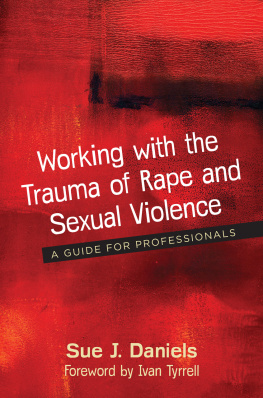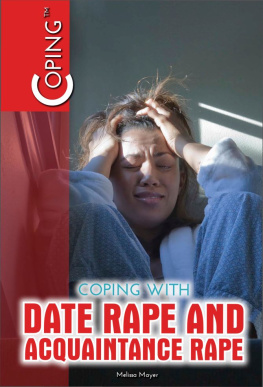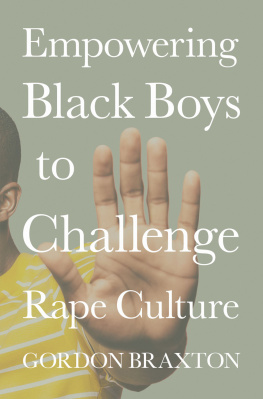Fraternity Gang Rape
PEGGY REEVES SANDAY
FRATERNITY GANG RAPE
Sex, Brotherhood, and Privilege on Campus
Second Edition

NEW YORK UNIVERSITY PRESS
New York and London
www.nyupress.org
2007 by New York University
All rights reserved
Library of Congress Cataloging-in-Publication Data
Sanday, Peggy Reeves.
Fraternity gang rape : sex, brotherhood, and privilege on campus / Peggy
Reeves Sanday. 2nd ed.
p. cm.
Includes bibliographical references and index.
ISBN-13: 978-0-8147-4038-5 (pbk. : alk. paper)
ISBN-10: 0-8147-4038-3 (pbk. : alk. paper)
1. Gang rapeUnited StatesCase studies. 2. Greek letter
societiesUnited StatesCase studies. 3. College studentsSexual
behaviorUnited StatesCase studies. I. Title.
HV6561.S25 2007
306.77dc22 2006038925
New York University Press books are printed on acid-free paper, and their binding materials are chosen for strength and durability.
Manufactured in the United States of America
p 10 9 8 7 6 5 4 3 2 1
To three women who resisted
Carol Tracy
Andrea Ploscowe
Meg Davis
They emancipate women in universities and in law courts, but continue to regard her as an object of enjoyment. Teach her, as she is taught among us, to regard herself as such, and she will always remain an inferior being. (The Kreutzer Sonata, Tolstoy, 1889)
When Im older and turning grey, Ill only gang bang once a day. (Ditty, American College Fraternity, 1983)
Contents
Introduction to the Second Edition
In the dark cold days of February several weeks into the spring semester, a student of mine at the University of Pennsylvania, whom Ill call Laurel, got high on a combination of LSD and beer before going to a fraternity party on campus in search of a good time. People at the party reported that during the course of the evening her behavior attracted quite a bit of attention as she danced provocatively to the beat of music only she could hear. She seemed disoriented and out of touch with her surroundings, oblivious to the various fraternity brothers who danced with her during the course of the evening. Some of the brothers spun her around until she was so dizzy she couldnt find her way out of the room.
According to various eyewitness and hearsay accounts, after the party was over five or six of the brothers had sex with Laurel. When Anna, who had observed Laurels behavior at the party, heard the brothers bragging about their sexual escapade the next day, she concluded that Laurel had been raped. According to Anna, Laurel was incapable of consent due to her drunken-drugged condition. At a rally held to protest the event weeks later, after word got out on campus about what had happened, Carol Tracy, then director of Penns Womens Center, referred to the 1983 legal definition of rape when she said:
The law is clearif a woman does not consent and is forced to have sexual intercourse, it is rape; if a woman cannot consent, it is rape.
By the year 2000 the Pennsylvania rape statute spelled out the meaning of consent even more clearly than in 1983:
A person commits a felony of the first degree when he or she engages in sexual intercourse with a complainant:
By forcible compulsion.
By threat of forcible compulsion that would prevent resistance by a person of reasonable resolution.
Who is unconscious or where the person knows that the complainant is unaware that the sexual intercourse is occurring.
Where the person has substantially impaired the complainants power to appraise or control his or her conduct by administering or employing, without the knowledge of the complainant, drugs, intoxicants or other means for the purpose of preventing resistance.
Who suffers from a mental disability which renders the complainant incapable of consent.
Who is less than 13 years of age.
On many campuses, then and now, sex with a drunken, nearly comatose, or passed-out woman is not defined as rape by the male participants. One cannot understand campus rape without seeing it in the context of the sexual culture that breeds the behavior. Often the male leaders characterize their role as passive despite the fact that they stage scenarios which they call hitting or riffing on women. The passivity the men attribute to themselves is the prelude for blaming the victim later.
A woman who gets drunk is said to be asking for it. This is true despite the fact that fraternity brothers admit that the goal of their parties is to get em drunk and go for it and that they make the womens drinks really strong to loosen up some of those inhibitions. As a rule, getting women drunk as a prelude to getting laid is as far as it goes. However, in some cases the go for it attitude spills over into the acquaintance rape of an inebriated party guest who is unable to give informed consent. When a woman is particularly vulnerable, acquaintance rape turns into gang rape as a group of brothers take advantage of a woman who is clearly out of it.
In the case of Laurel the XYZ (a pseudonym for the fraternity) brothers claimed that she had lured them into a gang bang or train, which they described as an express. They thought of what had happened as a routine part of their little sisters program, something to be proud of. Reporting the party activities on a sheet posted on their bulletin board, they described what had happened as interviewing for the little sisters program. They proposed that the name for the program should be little wenches, and the XYZ Express.
The XYZ brothers never publicly admitted to wrongdoing. I concluded (as did the local DA) that what had occurred at the XYZ house was rape as the term was legally defined. This conclusion was based on my talks with Laurel and interviews with students who had observed her behavior at the party, as well as other evidence presented in these pages.
My purpose in conducting the research for this book was to understand the shadow sexual culture that ensnared a drunk, vulnerable woman who was out of control. I wanted to bring to the public eye an event that I learned was common on college campuses. My goal was to erase the divide between what is well known to many male college students but hidden from the public sphere of debate and action. In the aftermath of the incident, the brothers first instinct was to brag about what had happened, thinking it would increase their status on campus. When the fraternity faced a one-year expulsion from campus, the brothers claimed that it was common knowledge that such events took place frequently. Defending their actions in a lawsuit against the university, they testified that excessive drinking occurred not only on weekends but at all times. They also testified that it was common for multiple consensual sexual intercourse to occur in one evening on the University campus approximately one to two times per month.
Appalled at the glimpse of university life presented to her, the hearing judge, Lois Forer, asked whether there were rules regarding consumption of alcoholic beverages and having visits by members of the opposite sex at fraternities. She was told in response by the counsel for the plaintiff: The only thing in the University Code of Conduct says members of the university community shall not act immaturely, whatever that means.
The meaning of whatever that means is the subject of this book. After some sixteen years, there is still a need to address this topic. The many cases reported since the book was published confirm the repetition of a common pattern up to the present. In 2003, reporting on the sexual assaults at the Air Force Academy, for example,
Next page












